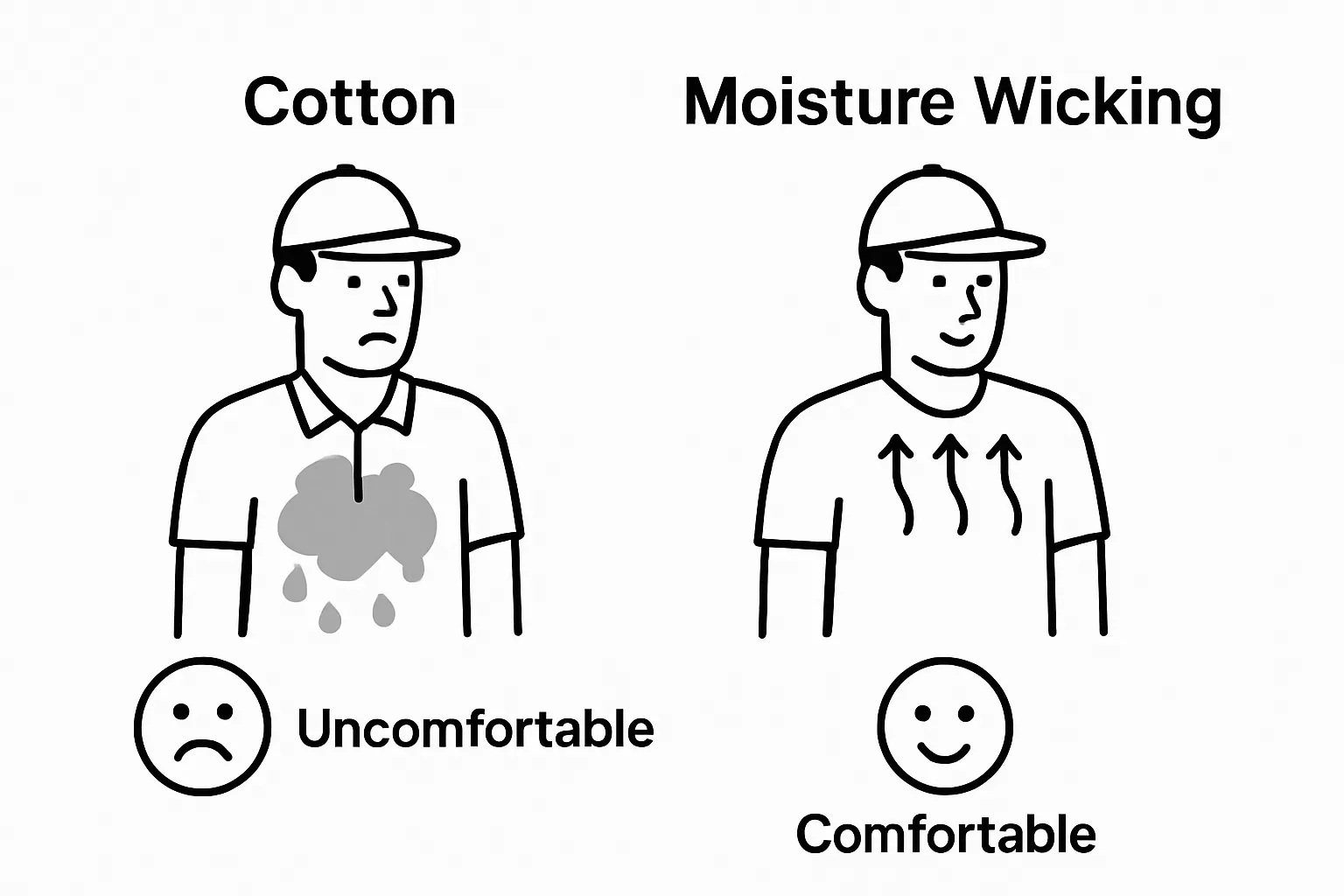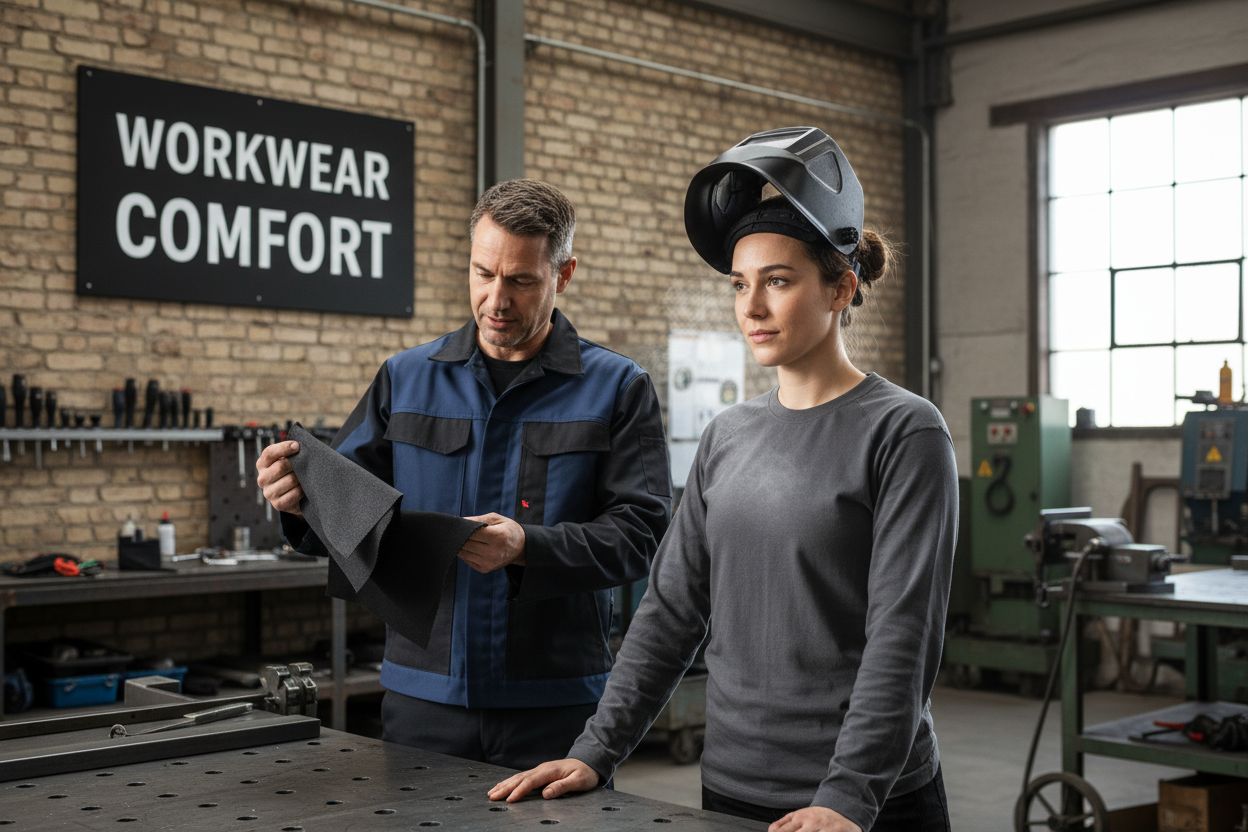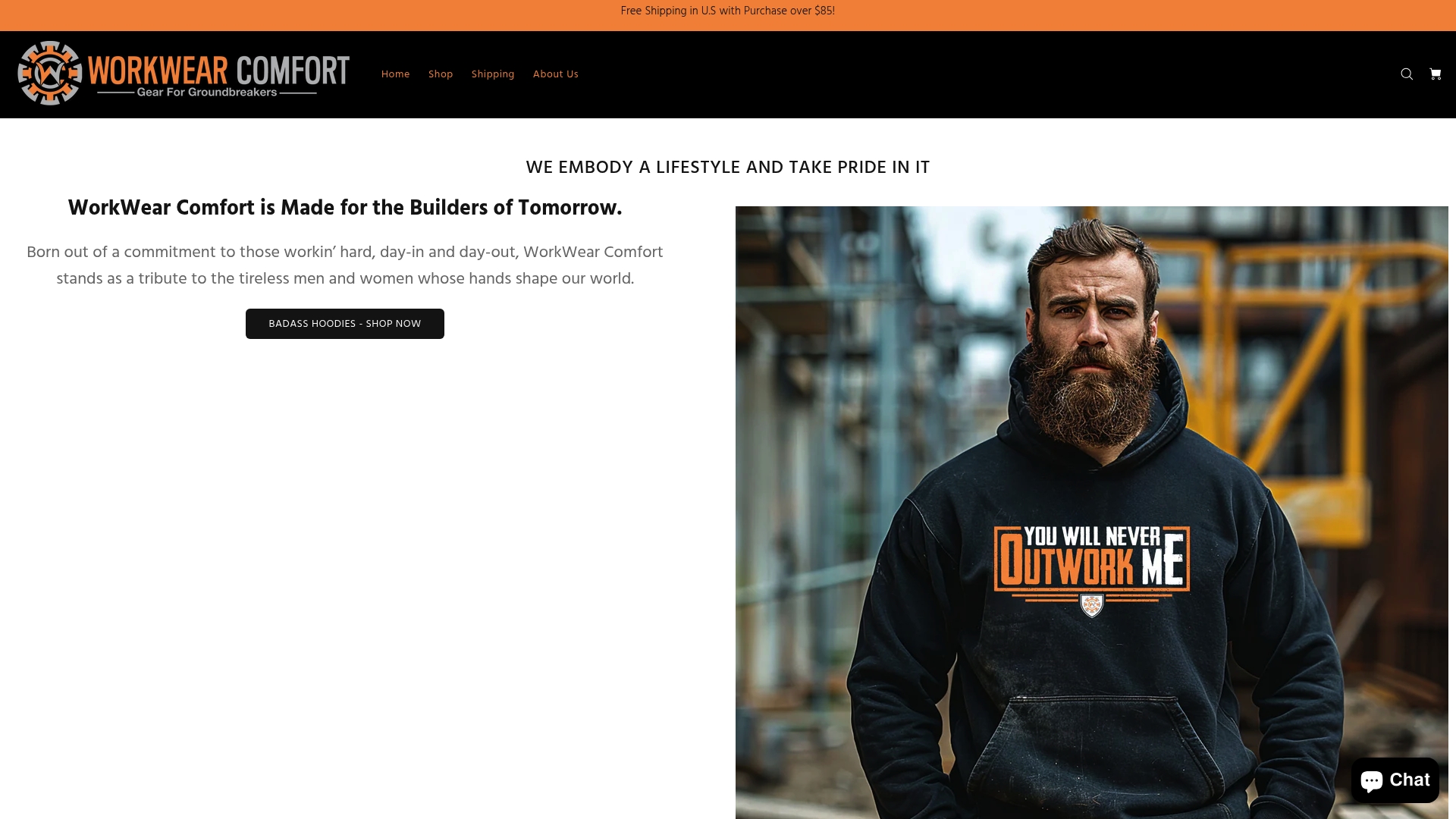Moisture wicking fabric has completely transformed how workers handle sweat and heat on tough jobs. Most people think sweat just soaks clothes and causes problems, but that is not how advanced workwear treats it. These fabrics can move sweat away from skin so quickly that studies show moisture management technology helps prevent productivity loss and reduces skin issues. What makes this tech even more surprising is how it uses science borrowed from nature itself to keep workers dry and comfortable on even the hottest days.
Table of Contents
- What Is Moisture Wicking And Its Fundamental Role?
- Why Moisture Wicking Matters For Workers In Tough Conditions
- How Moisture Wicking Fabric Works To Keep You Dry
- Key Concepts Behind Moisture Wicking Technology
Quick Summary
| Takeaway | Explanation |
|---|---|
| Moisture wicking improves comfort | It efficiently transports sweat away from the skin, ensuring a dry experience during physical activities. |
| Prevents skin-related health issues | Effective moisture management can mitigate risks like irritation and infections due to prolonged humidity on the skin. |
| Supports worker performance and safety | By regulating body temperature and reducing chafing, moisture wicking enhances work efficiency and lowers heat-related risks. |
| Choose specialized fabrics for workwear | Selecting advanced moisture wicking materials can transform standard clothing into performance-enhancing gear suitable for demanding tasks. |
| Understand fabric technology basics | Recognizing how materials interact with moisture helps in making informed decisions about work apparel for various environments. |
What is Moisture Wicking and Its Fundamental Role?
Moisture wicking represents a sophisticated textile technology designed to manage perspiration and enhance wearer comfort in challenging work environments. At its core, this innovative fabric engineering process involves creating materials that actively transport sweat away from the skin, enabling faster evaporation and temperature regulation.
The Science Behind Moisture Wicking
Moisture wicking fabrics function through capillary action, a natural physical phenomenon where liquid moves through microscopic spaces without external pressure. These specialized textiles utilize advanced fiber structures and chemical treatments that create pathways allowing moisture to spread rapidly across the fabric surface. By dispersing sweat quickly, the material enables faster evaporation, which helps workers remain dry and comfortable during intense physical activities.
Scientific research from the National Institutes of Health indicates that moisture management technologies are crucial in preventing skin-related health issues. The key mechanisms include:
- Rapid moisture transportation
- Quick evaporation rates
- Reduced skin moisture accumulation
Practical Applications in Workwear
For blue-collar workers exposed to physically demanding environments, moisture wicking technology provides critical advantages. Construction workers, welders, agricultural professionals, and first responders benefit significantly from clothing that keeps them dry and comfortable. The technology prevents excessive sweating from causing discomfort, reduces chafing, and helps maintain consistent body temperature during strenuous tasks.
By understanding moisture wicking principles, workers can select apparel that not only protects them from external elements but also manages internal physiological responses to heat and exertion. This technology transforms traditional workwear from simple protective clothing into sophisticated performance gear that supports human physical capabilities.
Why Moisture Wicking Matters for Workers in Tough Conditions
Blue-collar workers operating in physically demanding and extreme environments face significant challenges related to perspiration management. Moisture wicking technology emerges as a crucial solution that transforms workplace comfort and performance by addressing the complex physiological responses to heat and exertion.
Health and Performance Implications
Prolonged exposure to moisture can create substantial health risks for workers. Wet clothing against the skin increases potential for bacterial growth, skin irritation, and temperature regulation disruption. Occupational health research demonstrates that effective moisture management can prevent productivity loss and mitigate adverse health outcomes by maintaining optimal thermal comfort.
The critical challenges workers encounter include:
- Increased risk of heat stress
- Potential skin infections and rashes
- Reduced physical performance and concentration
- Higher likelihood of experiencing fatigue
Workplace Productivity and Safety Considerations
Moisture wicking technology directly impacts worker safety and efficiency. By rapidly moving sweat away from the body, these advanced fabrics help maintain consistent body temperature, reduce chafing, and minimize the potential for heat-related disorders. Welders, construction workers, agricultural professionals, and first responders particularly benefit from clothing that supports their physiological needs during intense physical labor.
Workers can explore our guide on hot weather workwear to understand how strategic clothing choices can enhance workplace comfort and performance. The right moisture management approach transforms workwear from basic protective gear into a sophisticated performance tool that supports human endurance and workplace resilience.
How Moisture Wicking Fabric Works to Keep You Dry
Moisture wicking fabric represents a sophisticated engineering solution that transforms how workers manage perspiration during intense physical activities. Unlike traditional textiles that absorb moisture, these advanced materials actively transport sweat away from the body through intricate molecular mechanisms.
Fiber Engineering and Capillary Action
Advanced textile research reveals that moisture wicking fabrics utilize specialized hydrophobic fibers designed to create microscopic channels. These engineered pathways enable rapid liquid transportation through capillary action, a natural physical phenomenon where liquid moves through tiny spaces without external pressure. The fabric’s molecular structure strategically pulls moisture from the skin’s surface and spreads it across a larger area, facilitating faster evaporation.
Key technical characteristics of moisture wicking materials include:
- Hydrophobic fiber composition
- Microscopic channel networks
- Rapid moisture dispersion capabilities
- Enhanced surface area for quick evaporation
Performance Dynamics in Workwear
The performance of moisture wicking fabric depends on complex interactions between fiber materials, weave structures, and chemical treatments. Synthetic materials like polyester and nylon are particularly effective because they possess inherent water-repellent properties. These fabrics are engineered to create a continuous moisture transportation system that prevents sweat from accumulating against the skin.

Workers across various industries can explore our comprehensive workwear guide to understand how advanced textile technologies can dramatically improve workplace comfort and performance. By selecting moisture wicking apparel, professionals transform their clothing from passive protection into an active performance tool that supports physiological regulation during demanding tasks.
Key Concepts Behind Moisture Wicking Technology
Moisture wicking technology represents a sophisticated intersection of textile engineering, materials science, and human physiological understanding. This advanced approach to fabric design goes far beyond traditional textile manufacturing, creating intelligent clothing solutions that actively respond to the wearer’s bodily functions.
Fundamental Scientific Principles
Advanced textile research demonstrates that moisture wicking technology leverages complex molecular interactions to manage perspiration. The core principles involve strategic manipulation of fabric fiber properties, surface tension, and molecular pathways that enable rapid moisture transportation.
Critical scientific foundations of moisture management include:
- Hydrophobic and hydrophilic fiber interactions
- Molecular surface engineering
- Thermal regulation mechanisms
- Capillary action principles
Material Science and Fabric Construction
Moisture wicking fabrics are engineered through precise combinations of synthetic materials, specialized weaving techniques, and advanced chemical treatments. Polyester, nylon, and microfiber blends are particularly effective due to their inherent molecular structures that facilitate quick moisture movement. These materials are designed with microscopic channels and treatments that create a continuous transportation system, pulling sweat away from the skin and dispersing it across a broader surface area.
Workers interested in understanding more about performance apparel can explore our guide on workwear essentials to gain deeper insights into how advanced textile technologies transform workplace comfort. By comprehending these key scientific concepts, professionals can make informed decisions about selecting clothing that supports their physiological needs during demanding work environments.
Below is a table summarizing the key scientific and material principles underpinning moisture wicking as discussed in the article, helping readers quickly differentiate each core aspect.
| Principle or Concept | Explanation |
|---|---|
| Capillary Action | The natural movement of liquid (sweat) through microscopic spaces in fibers, enabling efficient moisture transport. |
| Hydrophobic & Hydrophilic Fibers | Use of water-repellent (hydrophobic) and water-attracting (hydrophilic) fibers to control sweat movement. |
| Molecular Surface Engineering | Chemical and structural modifications to fibers to enhance sweat spreading and evaporation. |
| Microchannel Network Construction | Creating microscopic channels in textiles to facilitate rapid moisture dispersion across fabric. |
| Synthetic Materials like Polyester | Preferred due to inherent water-repellent properties, making them efficient in moisture transportation systems. |
| Thermal Regulation Mechanisms | Processes that support bodily temperature control by moving sweat away from the skin for faster evaporation. |

Level Up Your Workday Comfort with Advanced Moisture Wicking Apparel
Real comfort on the job starts with workwear that actually solves your toughest daily struggles. If you are tired of clothes that stick, chafe, or leave you drenched after a long shift, you are not alone. The article explains why moisture wicking technology is key for managing sweat, reducing health risks, and staying focused on demanding work. Real workers know that staying dry is more than a luxury—it is essential for safety, confidence, and top performance.

Discover how our workwear essentials blend advanced moisture management with rugged durability. Find gear designed for your unique environment, whether that means staying cool in hot weather or choosing statement-making hoodies with the comfort and function you need. Do not wait for sweat and discomfort to slow you down—make the shift to workwear built for resilience and all-day dryness. Visit WorkwearComfort.com now and experience the difference firsthand.
Frequently Asked Questions
What is moisture wicking in workwear?
Moisture wicking is a textile technology that helps manage perspiration by actively transporting sweat away from the skin, allowing for faster evaporation and improved comfort in physically demanding environments.
How does moisture wicking fabric work?
Moisture wicking fabric works through capillary action, where specialized hydrophobic fibers create microscopic channels that pull moisture from the skin and spread it across the fabric surface for quicker evaporation.
What are the benefits of using moisture wicking workwear?
The benefits include improved comfort, reduced skin irritation and chafing, prevention of heat stress, and enhanced workplace productivity by keeping workers dry and maintaining optimal body temperature during intense physical activities.
Can moisture wicking technology help with health issues related to sweat?
Yes, moisture wicking technology can help prevent health issues such as skin irritation, bacterial growth, and heat stress by keeping the skin dry and maintaining appropriate thermal comfort during prolonged physical exertion.
Recommended
- Best Workwear for Hot Weather: Stay Cool & Protected in 2025 - WorkWear Comfort
- What Is Workwear? A 2025 Guide for Hardworking Professionals - WorkWear Comfort
- Understanding Sweatshirts: Versatile Apparel Explained – WorkWearComfort
- 7 Essential Tips for Choosing the Perfect Hoodie Sweatshirt – WorkWearComfort


